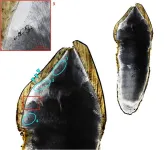(Press-News.org) EMBARGOED FOR RELEASE UNTIL 4 P.M. ET, WEDNESDAY, JANUARY 31, 2024
MINNEAPOLIS – People with polycystic ovary syndrome may be more likely to have memory and thinking problems in middle age, according to new research published in the January 31, 2024, online issue of Neurology®, the medical journal of the American Academy of Neurology. The study does not prove that polycystic ovary syndrome causes cognitive decline. It only shows an association.
Polycystic ovary syndrome is a hormonal disorder that is defined by irregular menstruation and elevated levels of a hormone called androgen. Other symptoms may include excess hair growth, acne, infertility and poor metabolic health.
“Polycystic ovary syndrome is a common reproductive disorder that impacts up to 10% of women,” said study author Heather G. Huddleston, MD, of the University of California, San Francisco. “While it has been linked to metabolic diseases like obesity and diabetes that can lead to heart problems, less is known about how this condition affects brain health. Our results suggest that people with this condition have lower memory and thinking skills and subtle brain changes at midlife. This could impact a person on many levels, including quality of life, career success and financial security.”
The study involved 907 female participants who were 18 to 30 years old at the start of the study. They were followed for 30 years, at which time they completed tests to measure memory, verbal abilities, processing speed and attention.
At the time of testing, 66 participants had polycystic ovary syndrome.
In a test measuring attention, participants looked at a list of words in different colors and were asked to state the color of the ink rather than read the actual word. For example, the word “blue” could be displayed in red, so the correct response would be red.
Researchers found for this test, people with polycystic ovary syndrome had an average score that was approximately 11% lower compared to people without the condition.
After adjusting for age, race and education, researchers found that people with polycystic ovary syndrome had lower scores on three of the five tests that were given, specifically in areas of memory, attention and verbal abilities, when compared to those without this condition.
At years 25 and 30 of the study, a smaller group of 291 participants had brain scans. Of those, 25 had polycystic ovary syndrome. With the scans, researchers looked at the integrity of the white matter pathways in the brain by looking at movement of water molecules in the brain tissue.
Researchers found that people with polycystic ovary syndrome had lower white matter integrity, which may indicate early evidence of brain aging.
“Additional research is needed to confirm these findings and to determine how this change occurs, including looking at changes that people can make to reduce their chances of thinking and memory problems,” Huddleston said. “Making changes like incorporating more cardiovascular exercise and improving mental health may serve to also improve brain aging for this population.”
A limitation of the study was that polycystic ovary syndrome diagnosis was not made by a doctor but was based on androgen levels and self-reported symptoms, so participants may not have remembered all the information accurately.
The study was funded by the University of California, San Francisco.
Learn more about brain health at BrainandLife.org, home of the American Academy of Neurology’s free patient and caregiver magazine focused on the intersection of neurologic disease and brain health. Follow Brain & Life® on Facebook, X and Instagram.
When posting to social media channels about this research, we encourage you to use the hashtags #Neurology and #AANscience.
The American Academy of Neurology is the world’s largest association of neurologists and neuroscience professionals, with over 40,000 members. The AAN is dedicated to promoting the highest quality patient-centered neurologic care. A neurologist is a doctor with specialized training in diagnosing, treating and managing disorders of the brain and nervous system such as Alzheimer’s disease, stroke, migraine, multiple sclerosis, concussion, Parkinson’s disease and epilepsy.
For more information about the American Academy of Neurology, visit AAN.com or find us on Facebook, X, Instagram, LinkedIn and YouTube.
END
Polycystic ovary syndrome tied to memory, thinking problems
2024-01-31
ELSE PRESS RELEASES FROM THIS DATE:
Advanced simulations to provide new understanding of supermassive black holes
2024-01-31
Rochester Institute of Technology scientists will be the lead researchers on a $1.8 million NASA grant to study electromagnetic signals from merging supermassive black holes.
RIT’s Manuela Campanelli, Distinguished Professor in the School of Mathematics and Statistics and director of the Center for Computational Relativity and Gravitation, will lead the collaborative project with help from Yosef Zlochower, professor in the School of Mathematics and Statistics. The project will also include researchers from the University of Idaho, Johns Hopkins University, and the Goddard Space Flight Center.
The team will combine astrophysical knowledge with state-of-the-art ...
Researchers find enzyme plays much larger role in preventing neurodegenerative diseases
2024-01-31
Indiana University researchers in the College of Arts and Sciences in Bloomington have identified a missing link that can help protect the brain from aging.
Hui-Chen Lu, professor and director of the Linda and Jack Gill Center for Biomolecular Science at IU, alongside graduate students Sen Yang and Zhen Xian Niou, found that nicotinamide nucleotide adenylyl transferase 2, or NMNAT2, provides energy to axons independent of the mitochondria. It does this by propelling glycolysis, a process in which glucose is broken down to produce energy. This gives axons enough energy to ...
CU Anschutz researchers identify new biomarker in quality of blood donations
2024-01-31
AURORA, Co. (January 31, 2024) - A collaborative cohort of researchers, led by University of Colorado Anschutz Medical Campus professor Angelo D’Alessandro, have identified kynurenine as a critical new biomarker in the quality of stored red blood cells (RBCs), a crucial step in the development of more personalized transfusions. Study results published today in the journal Blood.
The transfusion of RBCs is one of the most common in-hospital medical procedures second only to vaccination. The blood supply is dependent on altruistic blood donors, and donated RBCs are stored ...
38% of surveyed Danish owners put their dogs on unlicensed cannabinoids
2024-01-31
In a new study, 38 percent of dog owners surveyed in Denmark reported giving their pups cannabinoids, particularly cannabidiol or CBD. Pernille Holst and colleagues at the University of Copenhagen, Denmark present these findings in the open-access journal PLOS ONE on January 31.
Cannabis has become popular for recreational and medical use in humans, and many cannabis-based products are also available for pets. But because cannabis is not legal for veterinary use in countries such as Denmark, pet owners are using it without a prescription. To understand how common unlicensed cannabinoid use for pets is in Denmark, Holst and colleagues distributed an anonymous ...
After big shocks such as the pandemic lockdowns and the invasion of Ukraine, happiness levels may return to normal in as little as 2-3 weeks, per sentiment analysis of tweets in ten countries
2024-01-31
After big shocks such as the pandemic lockdowns and the invasion of Ukraine, happiness levels may return to normal in as little as 2-3 weeks, per sentiment analysis of tweets in ten countries
###
Article URL: https://journals.plos.org/plosone/article?id=10.1371/journal.pone.0295896
Article Title: Reactions to macro-level shocks and re-examination of adaptation theory using Big Data
Author Countries: South Africa, New Zealand
Funding: The authors received no specific funding for this work. END ...
Non-invasive wearable devices might be able to predict preterm birth by monitoring changes in maternal heart rate variability
2024-01-31
Non-invasive wearable devices might be able to predict preterm birth by monitoring changes in maternal heart rate variability
###
Article URL: https://journals.plos.org/plosone/article?id=10.1371/journal.pone.0295899
Article Title: Wearable-derived maternal heart rate variability as a novel digital biomarker of preterm birth
Author Countries: USA
Funding: The authors received no specific funding for this work. END ...
Childhood vitamin D deficiency was likely prevalent during industrialization in England
2024-01-31
Evidence from teeth reveals that vitamin D deficiency during childhood was likely a major issue in industrialized England, according to a study published January 31, 2024 in the open-access journal PLOS ONE by Anne Marie Snoddy of the University of Otago, New Zealand and colleagues.
The 18th and 19th centuries AD were a period of industrialization and urbanization in England. This was also a time of increasing incidence of health issues like vitamin D deficiency (VDD) and associated conditions like rickets, potentially linked to changing social practices ...
Archaeological evidence of seasonal vitamin D deficiency discovered
2024-01-31
Rickets ran rife in children following the Industrial Revolution, but University of Otago-led research has found factory work and polluted cities aren’t entirely to blame for the period’s vitamin D deficiencies.
In a Marsden funded study, just published in PLOS One, researchers from Otago, Durham University, University of Edinburgh, University of Brighton, and University of Queensland, sampled teeth from a cemetery site in industrial era England, looking for microscopic markers of nutritional disease.
Lead author Dr Annie Sohler-Snoddy, Research ...
Jennifer J. Raab named President and CEO of The New York Stem Cell Foundation
2024-01-31
NEW YORK, NY (January 31, 2024) – The New York Stem Cell Foundation (NYSCF) announced today that, following a nationwide search, its Board of Directors has named Hunter College President Emerita Jennifer J. Raab as its next President and Chief Executive Officer, effective this month.
NYSCF is one of the world’s leading nonprofit stem cell organizations, raising and investing more than $450 million since its founding in 2005 to accelerate cures for the major diseases of our time through stem cell research. The foundation conducts its own pioneering research at the NYSCF Research Institute laboratories in Manhattan, informs and convenes scientists and ...
A new way to visualize brain cancer
2024-01-31
Brigham and MIT researchers uncovered never-before-seen details in human brain tissue with new, inexpensive microscopy technology.
KEY TAKEAWAYS
Researchers have developed a new microscopy technology called decrowding expansion pathology (dExPath) to analyze brain tissue.
By pulling proteins apart with dExPath, researchers can stain proteins in tissue that could not be accessed before, highlighting nanometer sized structures or even cell populations that were previously hidden.
This “super-resolution imaging” technology ...






